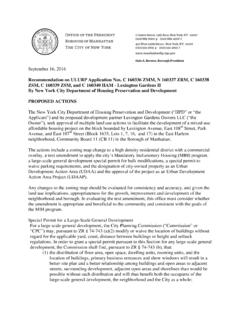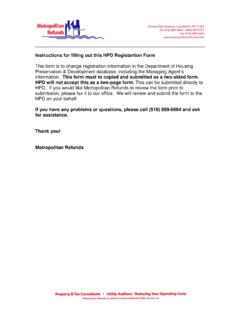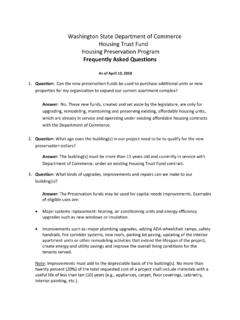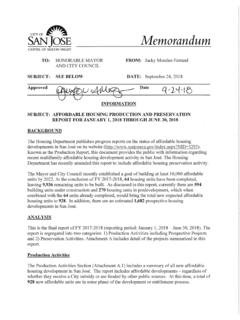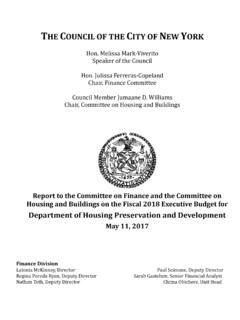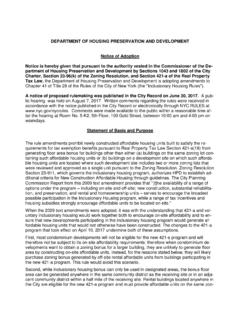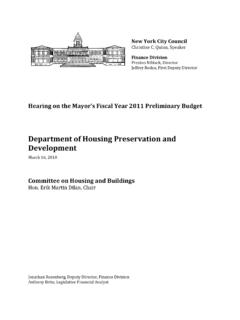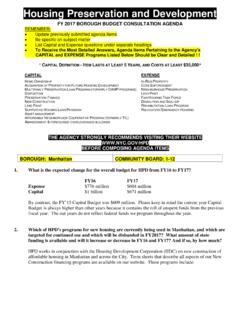Transcription of Chapter 7 Neighborhoods, Historic Preservation and Housing
1 7 Neighborhoods, Historic Preservation and Housing Livable neighborhoods; cleaner neighborhoods; more Housing . Birmingham has a sweet and vibrant historical aspect that most certainly needs Preservation . We will always be known for it, but we can also create new interests and opportunities for our should be more options. PERSONAL VISION OF BIRMINGHAM COMPREHENSIVE PLANPART III | Chapter 7 NEIGHBORHOODS, Historic Preservation AND HOUSINGGOALSPOLICIES FOR DECISION MAKERS communities and neighborhoodsNeighborhoods are enhanced by investments to improve quality of life. Support strategic initiatives with integrated investments to improve the physical, environmental, functional, and social conditions and make a visible difference. Support creation of framework plans for Birmingham s Communities, incorporating existing neighborhoods plans as appropriate. Coordinate with the Housing Authority, School department , county, state, and federal agencies about locating new facilities and disposition of properties.
2 Urban Villages and community/neighborhood centers provide access to retail and services. Focus investments to support walkable neighborhood commercial districts, including Main Street districts and compact centers along arterials. Locate public facilities, civic and cultural uses within or adjacent to neighborhood commercial districts to act as neighborhoods have a good public image. Support a marketing program for the city as a place to live, work, study, and Citizen Participation Plan continues to serve residents and the city well. Update the citizen participation preservationThe integrity and character of distinctive Historic structures and districts is maintained and enhanced. Coordinate city programs and policies to support Historic Preservation initiatives support and invigorate community/neighborhood renewal. Support programs and incentives for Historic Preservation that renew neighborhoods and commercial districts, and further economic comprehensive Housing policy supports quality neighborhoods.
3 Support a community-based system to develop and implement a citywide Housing policy that includes stakeholders from government, the nonprofit sector, and the private Housing is in good condition and code compliant. Support effective, efficient, and sensitive code enforcement Housing meets the diverse needs of households at all income levels and all stages of the life cycle. Support the planning, regulatory and funding initiatives needed to provide a diversity of Housing types, rental and ownership, market-rate and assisted, to meet community OF BIRMINGHAM COMPREHENSIVE PLANPART III | Chapter 7 NEIGHBORHOODS, Historic Preservation AND HOUSINGCOMMUNITIES AND NEIGHBORHOODSThe majority of the neighborhoods and Housing in the city date from before historical reasons, some neighborhoods are located in environmentally compromised locations (for exam-ple, near industrial sites with a history of pollution or in flood plains)
4 And have experienced significant popula-tion a few neighborhoods, strategic and focused atten-tion by nonprofits, foundations, faith-based groups, and resident investment has created momentum for vacancy rates in neighborhood commercial districts are commercial corridors that border or go through neighborhoods are characterized by low-density, low-value development and high levels of Birmingham s Main Street program includes nine neighborhood commercial districts, but has been un-derfunded and changes and applications for demolition permits for properties located in a designated Commer-cial Revitalization District are subject to urban design neighborhood/community system of public par-ticipation was established in the 1970s and based on a larger population and a different climate for community development PRESERVATIONB irmingham has 146 individual sites and multi-site his-toric districts listed on the National Register of Historic Places, including three National Historic Landmarks, nine Historic fire stations, and three Historic apartment hotel groupings.
5 It also has 40 National Register His-toric Districts with multiple properties. Property owners can make changes or demolish properties listed on the National Register that are not located in a local Historic district or a Commercial Revitalization District or are not subject to a Historic Preservation easement, as long as they conform to federal, state, and local are nine local Historic districts in which property owners are subject to Historic design review of exterior changes to the two-thirds of Birmingham Housing units are single family houses. City of Birmingham households are almost equally divided between owners (49%) and renters (51%). Housing vacancy rates are high: 18% of Birmingham s Housing units are vacant for rent or sale, or out of the market. Seven percent of total units are vacant and out of the of Birmingham s Housing stock is old and obso-lete and does not meet modern rate Housing is affordable to the household making the median regional income, but the city has many households with incomes well below the regional median sales price for a single family house in late 2011 was $116,000, while the average cost of building a new house is $130, are approximately 6,000 occupied publicly-as-sisted Housing units owned by the Housing Authority or assisted through Low-Income Housing Tax Credits.
6 The Housing Authority also owns an additional unoccupied 1,951 units slated for improvements or other projects, and administers 5,138 Housing choice vouchers (sec-tion 8). Two HOPE VI have successfully transformed public Housing into mixed-income developments, downtown and in Ensley, and the Housing Authority has applied for a federal Choice Neighborhoods Initiative implementation grant to transform the Loveman public Housing development in North funding to the city for community development and Housing programs has declined significantly since the OF BIRMINGHAM COMPREHENSIVE PLANPART III | Chapter 7 NEIGHBORHOODS, Historic Preservation AND HOUSINGThe need for decent, affordable Housing remains high. Half of renters are estimated to spend more than 30% of their income on Housing and 41% of homeowners spend more than 30% of their income on the 2006-2011 period, encompassing the Great Recession, the sales price of City of Birmingham homes declined High foreclosure rates add to Housing market weakness or failure in some city neighborhoods.
7 In December 2011, 38% of homes listed for sale in the city were in (continued)challengesStabilizing the continuing trend of a decline in the number of households that creates an oversupply of safe, decent and affordable Housing to all weak Housing markets that exist in a number of neighborhoods to promote market rate Housing neighborhood support for all residents while taking a strategic approach to neighborhood and hous-ing the neighborhood/community association neighborhood-serving retail and services in appropriate OF BIRMINGHAM COMPREHENSIVE PLANPART III | Chapter 7 NEIGHBORHOODS, Historic Preservation AND HOUSINGA. What the Community SaidDuring the public participation process, Birmingham residents and stakeholders identified the issues most important to them related to neighborhoods and Housing : Many neighborhoods have good Housing stock and op-portunities for investment. In some neighborhoods, Housing with code violations and blight affects the value of occupied homes in good repair.
8 Residents all over the city would like better access to retail and services and the revitalization of traditional neighborhood commercial districts. Historic areas that do not have local Historic districts need incentives to promote Housing rehabilitation. Past development decisions allowing incompatible mul-tifamily development affect nearby values. Absentee landlords need to be held accountable for maintenance and adequate conditions in Understanding NeighborhoodsNEIGHBORHOOD POLICYN eighborhood types and characterCreating neighborhoods of choice. Successful 21st century cities offer a high quality of life, and good neighborhoods are the bedrock of quality of life. Businesses locate where people want to be, and good neighborhoods, along with a great open-space system, a vibrant cultural life, and good transportation options rank among the key attractions that any city can offer. As jobs increasingly follow people in the 21st century, rather than the other way around, investing in a high quality of life is also an economic development strategy.
9 Good neighborhoods are safe, clean and healthy, supported by well-maintained and well-run public services. They are comfortable and attractive, easy to access and get around, and provide multiple transportation choices for travel to and from the neighborhood. To many people, good city neighborhoods have the advantage of diversity, whether among the people who live there or the variety of uses and things to do. Ultimately, good neighborhoods are about people and connections. The physical and social organization of a neighborhood should encourage people to get to know and trust one another. Good neighborhoods often have traditions expressed in care for public places such as a school or park, in festivals, and in holiday activities. In order to be successful, each neighborhood within the city, regardless of household income level, should provide safety; decent and sanitary Housing ; infrastructure and multi-modal transportation systems that are well-maintained; environmental and aesthetic amenities such as street trees; and easy access to parks, public spaces, and neighborhood retail and services.
10 These are the characteristics of neighborhoods of urban neighborhood character and form in Birmingham. Neighborhood character is a composite of many features that together give an area its distinctive physical form and appearance. These features tend to affect social interactions. For example, neighborhoods without sidewalks do not encourage walking. Features that help define a neighborhood s character include streets, sidewalks, and street trees; the scale of buildings and public spaces; internal and external connections; building materials; architectural styles; land uses; the number and type of public and social spaces; Historic features; and development types. Many of Birmingham s neighborhoods originated as separate small towns. Like the city center, these neighborhoods are typically characterized by a grid of connected streets for easy walking, small to medium sized house lots, houses that face the street, small blocks, NOTE: For the purposes of this Chapter , references in the text to official, city-designated neighborhood associations and communities that are part of the citizen participation process will be capitalized as Neighborhood and Community.






